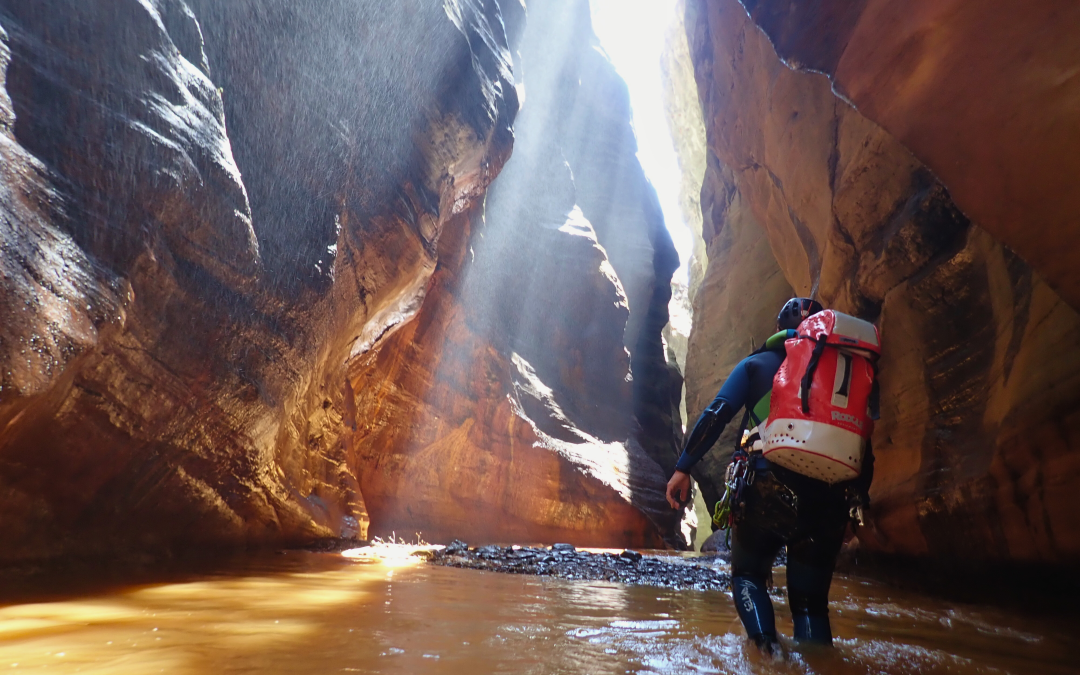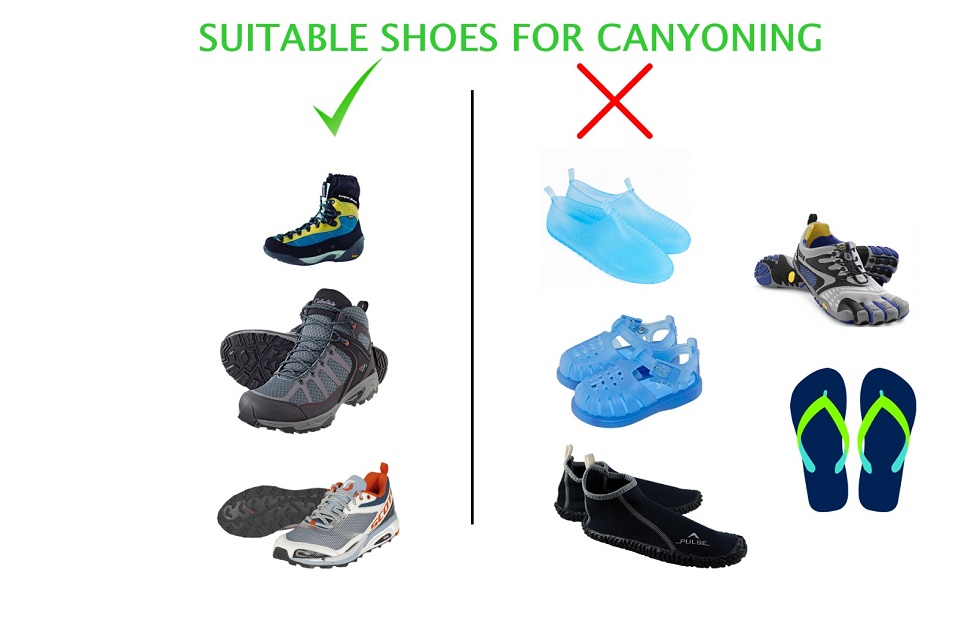Canyoning is an adventure sport with different levels of difficulty. Although some people may think that no special equipment is needed for lower level canyoning, as it can be confused with a ‘simple river walk’, it is important to be aware that canyoning, like all outdoor adventure activities, can involve some considerable risks: slippery surfaces and the possibility of injury from sharp objects such as stones and branches, or even falling rocks from the canyon walls, are more common than people think. In addition, prolonged exposure to cold water can cause discomfort or even cold-related health problems.
Fortunately, whether the slopes are small or large, these risks can be greatly reduced with the right equipment.
What basic equipment do I need to go canyoning?
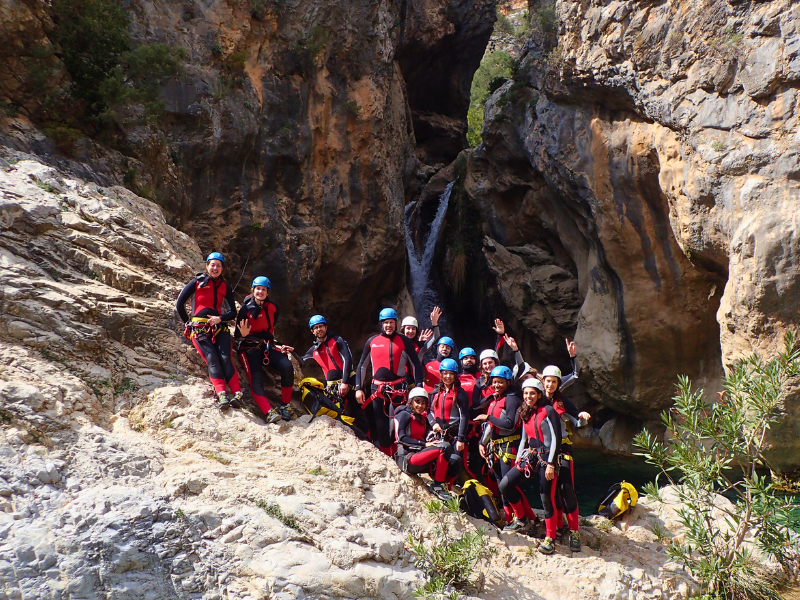
The basic equipment for canyoning consists of 4 main elements: Wetsuit, helmet, harness (with lanyards and descender) and footwear.
Some people neglect to use this equipment, sometimes due to cost, but mostly because of a lack of awareness. However, as you will see next, all these items are essential to enjoy canyoning in safety and comfort.
Wetsuit or Neoprene suit

This is a neoprene suit, similar to that used for diving or surfing, which in the case of canyoning can also be one or two-piece. This suit allows us to retain our body heat and, depending on its thickness, will protect us from small bumps and scratches, as well as giving us extra buoyancy in case of need or rescue.
Two-piece wetsuit
The two-piece suit consists of a sleeveless overall and a jacket, so that the chest area has double insulation covering the vital organs. The most commonly used two-piece suits are 5mm thick and are very versatile as they can be used as full suits in colder seasons, or just the overalls in the hottest months.
One-piece wetsuit
The one-piece suits are very comfortable and allow greater mobility. Although they are less versatile, they are also a little tighter fitting and allow less water to get in during jumps. One-piece wetsuits are usually used for children as they are more flexible.
Both one-piece and two-piece wetsuits usually have a hood, which we will use in the case of a winter canyon or thawing water.
What makes canyoning wetsuits different from other wetsuits?
Canyoning wetsuits differ from diving wetsuits in that they have greater reinforcements in the knee, elbow and seat areas, as these are the areas where we tend to lean and use more during the activity.
Canyoning suits don’t just protect us from the cold! It is a generalised idea that they only serve as insulation, but one of their main functions is to protect us from bumps and scratches against the stones or vegetation of the river bed.
Another of its great functions, especially in living water, is to give us great buoyancy. They allow us to float easily in the water, saving energy and giving us extra safety in places where there is foam and the water is less dense.
So these are the three main functions of canyoning wetsuits: it protects us from the cold, it protects us from impact and it helps us to float.
Helmet
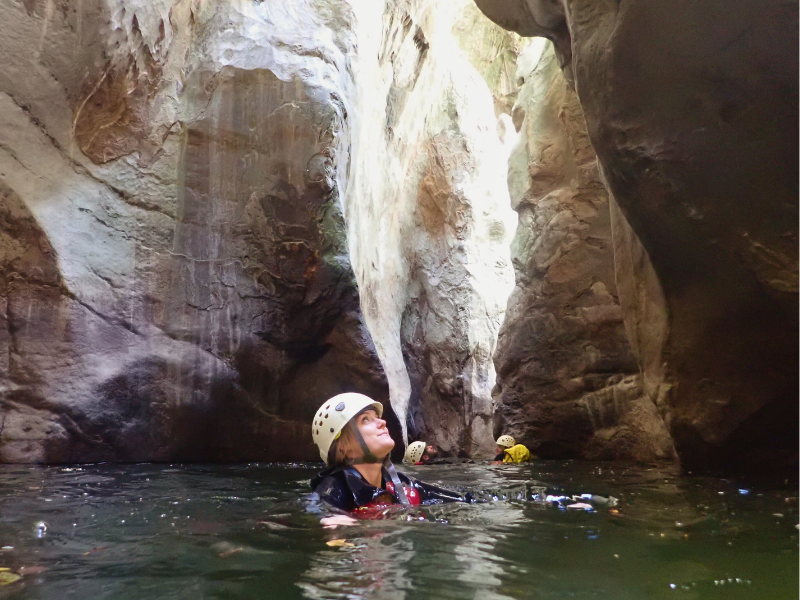
The various articles in the media and our own experience in many mountain sports (MTB, climbing, via ferratas, motorcycling…) have taught us that the helmet is one of the most fundamental elements of safety in many sports and mountain activities, including canyoning.
What is the main function of a canyoning helmet?
When it comes to canyoning, the popular idea is that the helmet is only useful when you slip and fall. This is not the case. The biggest danger and the most important function of the helmet in canyoning is to absorb the impact of a stone falling from above in a narrow part of the canyon. This is the same kind of protection as in multi-pitch climbing, where one of the main dangers is the rocks falling from the highest part of the peak.
The shell also protects you from being hit in areas with living water, where you are more exposed to the current, and in areas where you have to bend down to pass under a rock, a cave or a siphon.
Can I use any helmet for canyoning?
Helmets must be approved for this sport, do not use bicycle helmets or other helmets that are not specifically designed for canyoning. Make sure that your helmet has no cracks or damaged absorbing elements. Good supervision and control of the equipment is also necessary.
Remember that helmets for rafting or white water descents have their own homologation, which is slightly different from that for canyoning. Always check with your supplier or with your guides if they use a specific helmet for the activity,
Harness
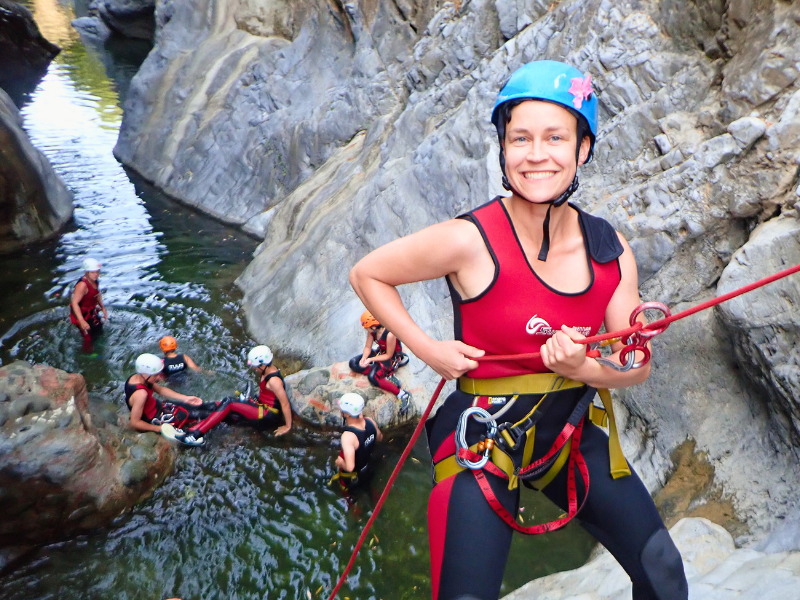
A harness is a piece of equipment that has three main straps that are connected to each other and that surround our waist and thighs (the yellow thing that appears in the picture above). It’s main purpose is to distribute the weight when we are hanging.
Today, there are many harnesses of different brands and qualities, ranging from simple harnesses to much more complex harnesses in terms of base material, reinforcements, belly ring area… We will not go into these details now. Brands such as Signing Rock (with more basic models and others more advanced), Fixe or Petzl (also with different qualities) are the most popular.
What makes canyoning harness different from other harnesses?
The harness for canyon descents has the peculiarity of having a ‘culera’, a very resistant plastic canvas that protects the buttocks from rubbing. As we progress, we will be using our buttocks a lot, sliding on slides, crawling on rocks, descending… and it is essential not to tear the neoprene.
Harnesses can also be used to attach various canyoning accesories, such as abseiling equipment and lanyards, and will be useful in the event of an emergency where a person needs to be extracted from the canyon. Let’s take a look to the two most used accesories for canyoning:
Lanyards or “bagas”
The lanyards or anchoring ropes (“baga” in Spanish) are an essential element for safe canyoning. They will help you to carry out several important actions; to anchor yourself to the handrails, to anchor yourself to the meeting points or to anchor yourself to the leader or guide when rappelling. You can already deduce that their main function is to anchor you from your harness to something. They are basically a couple of ropes or straps with carabiners at the ends (The two red strips with black details in the photo above).
Another function of the lanyard is to help your companions during the descent. If the descent is short, you can simply grab the carabiner of the lanyard to accompany your companion’s descent or ascent. If the descent is longer, you can attach the lanyard carabiner to an auxiliary rope and descend with the rope. It is also common to make an escape knot on one of the carabiners of the lanyard at the moment of securing an additional abseil (this safety would be done by the guide or leader with the auxiliary rope). So the lanyard has many functions and these are only the main ones.
What kind of lanyard is suitable for canyoning?
The lanyard must be double and a certified lanyard is recommended. There are different types of baga that can be bought, such as FIXE (slightly longer) or PETZL (slightly shorter), but this depends on the user’s preference. Although some canyoners choose to make their own lanyards with a rope and some carabiners and other accessories, professional guides and serious companies must use approved lanyards.
Descenders
There are many options for descenders and choosing one is not easy. In an attempt to keep this article short and to the point, we will recommend the most common and perhaps most versatile, the classic ‘eight’.
Eights are a metal tool consisting of two circles, one large and one small, joined together to form the shape of an “8” (hence the name). They act as a safety tool, helping to control a descent. You can see it on the far right of the photo above, connecting the red rope to the central carabiner of the harness.
In canyoning, they are used for several reasons: they allow you to descend quickly when rappelling and when you get down, the rope can be quickly removed; the rope can also be easily blocked to stop a descent; they allow many other manoeuvres such as blocks, lifts, clutches… In short, it offers the best balance between safety and versatility.
Footwear
Footwear is also a fundamental element of safety in canyoning. The sole plays the most important role in safety and must be designed to provide the best possible grip on dry, wet or submerged rock surfaces.
The best option is professional canyoning footwear which, in addition to providing optimum grip, is designed to withstand the aggressiveness of the environment and allow water to drain away more quickly. High socks are also recommended to prevent chafing and protect your ankles.
Can I use any shoe for canyoning?
If you don’t have professional canyoning boots, or can’t rent them, a good option is to use hiking boots, preferably with a Vibram sole and lateral reinforcements.
Conventional running shoes are not usually the best option, as the soles are usually very plasticized and you will slip and lose your balance as you walk. However, this option is better than nothing.
What is never allowed is open footwear such as flip-flops, water shoes or crocs, as you could easily slip and your toes could hit the rocks and break a phalanx. Even if they are closed, if the fit is poor or the sole is too soft, you could twist an ankle or injure the sole of your foot.
Renting professional canyoning shoes
At TUUR Canyoning we offer the possibility of renting professional canyoning boots “Bestard Aqua Pro” (those in the photo below) for all your canyoning trips.
Why don’t we include them in the price? Unlike the rest of the canyoning equipment, canyoning shoes are an optional item because many travellers already bring their own hiking boots or prefer to use their own sports shoes and save some money this way. Of course, we recommend that you hire professional canyoning shoes if you can afford them, as you will notice the difference when wearing them (even if they are not brand new): you will feel safer and more confident, which will ensure you have a more enjoyable experience.

Additional Equipment for Canyoning
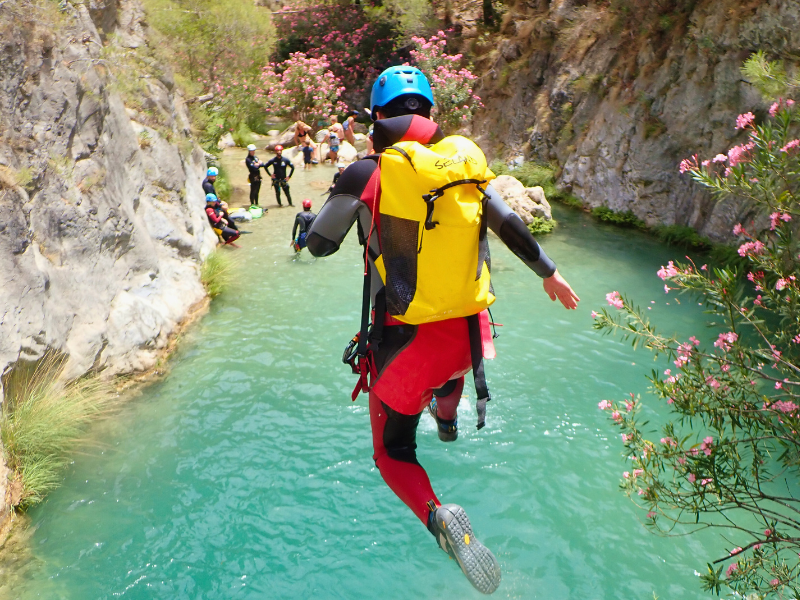
The following items are not essential as they are usually included in the guide’s backpack. But if you are thinking of going on your own, or are just curious, here are some optional canyoning items:
- Canyoning bag: This backpack is specially designed for canyoning and will hold all your extra items for the trip. They are usually made from PVC and have holes in the bottom to allow water to drain.
- Watertight canister: This is a very useful accessory to keep your belongings safe. You can put in some food/snacks, an extra headlamp in case the canyoning takes longer than planned, a mobile phone and an extra rope.
- A whistle: you can put it in your helmet or attach it to your backpack, and it will be useful to give signals in places where there are waterfalls or to give warnings over long distances.
- Knife: A tool that always comes in handy (and I’m not thinking of the film “127 Hours”…) and can be used in hundreds of situations. It can be tied to the wrist and carried inside the neoprene sleeve, or tied to the bib with a fine, longer rope and carried inside the jacket. If you’re venturing into living water, it’s best to keep it in your sleeve and as close to your hand as possible.
- Neoprene shirt: This shirt is made of thin neoprene, elastane and polyamide. It can be used as an extra layer in cold canyons, or as an intermediate garment to combine with the wetsuit in canyons where the wetsuit is not required. It is a good investment if you do a lot of water sports, and there are very nice models for both girls and boys.
There is a lot more hard rescue equipment that guides carry in their harness or backpack, such as ascenders, pulleys, different sized lanyards, grappling irons, plates, auxiliary ropes, first aid kit… But that’s for another article.
Conclusion
Now that you know the basic equipment for canyoning, you are aware that having the right equipment for canyoning is just as important as having the technical knowledge of canyoning techniques and knowing the canyon where you will be doing the activity.
We hope that this article will help you to choose the right equipment when you start your own way in this beautiful sport, or when you hire a guide / tour company, so that you can choose the best service.
See you in another blog!
TUUR Canyoning © 2025





